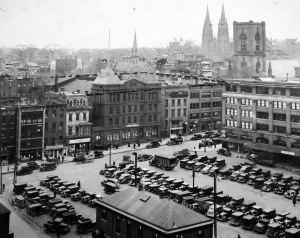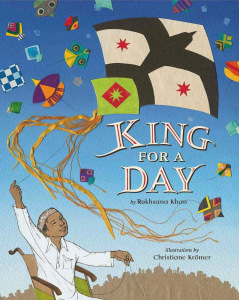Our thanks to Mike and Mary Ryan for their help with this post.
Ryan’s Farmers Market is an Albany institution, in business for over a century and still run by the same family. In 1901, 24-year-old William Frederick (Willie) Ryan began selling produce with his brother, Jimmie. Their shop at 104 Hudson Ave. was on a block that would later be demolished for the Albany Center Market expansion.
 The Lyon Block and public market before expansion, ca. 1930s. Albany Institute.
The Lyon Block and public market before expansion, ca. 1930s. Albany Institute.
Around 1908, the brothers set off in separate directions. Jimmie became a junk dealer: “You Weigh, We Pay.” Willie stayed in the produce trade and moved across the street to a storefront in the Lyon Block. There he would remain for more than a half century, until that massive structure was slated for demolition.
Perhaps what prompted the change was Willie’s plan to marry 19-year-old Jennie Brightmyer. The daughter of a German-born cigar-maker and Civil War veteran, she grew up on Sheridan Ave. in Arbor Hill. In November 1908, the couple were wed in the Cathedral of the Immaculate Conception and set up housekeeping at 140 Grand St., a short walk from the market. Within a year, Jennie was pregnant with a daughter, Margaret.
As the Ryan family grew, the business prospered. W. F. Ryan Produce, Inc. sold vegetables from the family’s farm, along with local and imported fruit, including wine grapes in the summer and citrus in the winter. But Willie, the son of an Irish immigrant father, was famous for his Irish potatoes.
 The Lyon Block and public market, ca. 1921. Albany Institute.
The Lyon Block and public market, ca. 1921. Albany Institute.
Before 1919, Willie consistently promoted White Star potatoes among other produce. But during the Anglo-Irish War, the Irish potato took center stage. Willie’s advertisements became increasingly topical and political. One of the first such ads we’ve found is from April 1919, published in the Albany Evening Journal as diplomats gathered in Paris to negotiate an end to the First World War:
About the time the Sixty-ninth lands in New York, they will be hanging their brothers in Cork. Johnny Bull will be telling other nations how to walk. But of Irish freedom they must not talk. We can talk of Irish potatoes and have the best, $1.50 bu., delivered; turnips, carrots, beets and parsnips 5¢ qt; bunch onions, rhubarb and spinach, 30¢ pk.
 State troopers escort a trolley during the strike, February 1921. Via Albany Group Archive on flickr.com.
State troopers escort a trolley during the strike, February 1921. Via Albany Group Archive on flickr.com.
The year 1921 was pivotal for both the Irish Republic and local government in Albany. In this city, the year began with a bitter trolley strike and ended with the wholesale defeat of Billy Barnes’s Republican machine, which had controlled City Hall since the turn of the century. That year Willie wrote in support of the striking workers, the rising Democratic organization, Irish independence, and his brother Jimmie’s run for the office of 5th ward alderman. (Jimmie, we were surprised to discover, was a Republican and lost in the Democratic sweep.)
A Ryan potato figured prominently in the 1921 election. A few weeks before the election, while State Senator Frank L. Wiswall, chair of the Albany County Republican Party, was addressing his supporters, several people began throwing potatoes at the speaker. An “over-ripe” one hit him on the side of the face. According to the Barnes-controlled Albany Evening Journal, the unidentified potato-throwers appeared to have arrived with Edward Corning, father of the future mayor and chair of the local Democratic Party. Corning had just interrupted the rally, waving his arms and yelling up to the speaker, “Here I am, what have you got to say about me?”
 From the Knickerbocker News, January 9, 1946. Used by permission of the Times Union.
From the Knickerbocker News, January 9, 1946. Used by permission of the Times Union.
Wiswall and the Republicans used this incident as evidence of Democratic “rowdyism.” Corning and his supporters indignantly denied responsibility, blaming instead a pre-adolescent prankster. Willie, however, took credit for the potato:
The Republican party knows it was not a Corning potato. It was an Irish potato. And from what my trade tells me, it must have been one of my potatoes, for they say ‘they always reach the spot.’ We have plenty more at $1.25 a basket….
Story sound familiar? You might remember a fictionalized version of this incident from William Kennedy’s novel about the O’Connell-Corning machine, Roscoe. By World War II, Willie and his editorial ads had become an Albany institution, as had Ryan’s Produce. In the 1930s, when farmers and wholesalers moved en masse from downtown Albany to the new cooperative market in Menands, Willie stayed put, perhaps out of loyalty to his customers or to the city’s leaders, who bitterly fought the move. (The expansion of the Albany Center Market was one result of this fight.)
In 1924, tragedy struck the Ryan family. A car hit Willie and Jennie’s 14-year-old daughter Margaret on her way to a music lesson. Margaret was hospitalized for months before succumbing to her injuries. Three years later, Jennie gave birth to a baby boy, William F. Ryan Jr. Little Willie would follow in his father’s footsteps.
 At the market, ca. 1950s. Albany Institute.
At the market, ca. 1950s. Albany Institute.
Twenty years later, after serving in the merchant marine during the Second World War, Little Willie returned home to Albany, finishing high school and working beside his father in the family business. Like his father, Little Willie was a born salesman, as Mary Nuciforo can attest. He was working at the store one day, when he noticed her walk by on the way from her Hamilton St. home to her job on Beaver St. He called out to her, but she refused to speak with him. He was a stranger, after all. Every day as she walked by, he would call out a different name, until finally he got it right.
William Jr. and Mary were wed in St. Anthony’s Church (now the home of Grand Street Community Arts) in 1954, and she came to work at the store, acting as the company’s bookkeeper. A new generation of Ryans was ready to take over the family business.
Advertisements Share this:





